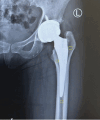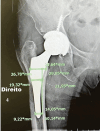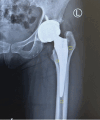A Retrospective Cohort Study of the Effects of Canal Filling Ratio and Femoral Bone Density Change on the Outcomes of Anatomical and Double-tapered Wedge Stems
- PMID: 39649047
- PMCID: PMC11624936
- DOI: 10.1055/s-0044-1787770
A Retrospective Cohort Study of the Effects of Canal Filling Ratio and Femoral Bone Density Change on the Outcomes of Anatomical and Double-tapered Wedge Stems
Abstract
Objective This study aims to compare the proximal femoral bone density changes in follow-up X-ray imaging and the proximal filling ratios of stems between anatomical and double-tapered wedge stem designs. Methods Patients aged between 18 and 80 years who received primary total hip arthroplasty using both types of stems between 2017 and 2019 and had follow-up tests for up to a year were included in the study. Canal filling ratios at 3 levels (lesser trochanter [LT], 2 cm above LT, and 7 cm below LT) using the optimal densitometry method. Femoral bone density changes were measured using the Gruen zoning method. Results A total of 92 patients (76% female and 24% male) met the inclusion criteria for this study. The mean age was 53.86 ± 13.00 years. The canal filling ratio in the double-tapered wedge group (Accolade II) was significantly higher than that in the anatomical stem group (ABGII) ( p < 0.001, p < 0.001, and p = 0.013) for all levels of measurement. No significant difference was observed between both types of stems in femoral bone density changes in zones 1 and 4. However, there were significant differences in femoral bone change, with bone loss being higher in the anatomical stem group in zone 7 (-25% versus -17%; p = 0.010). Conclusion Double-tapered wedge stem had a significantly higher canal filling ratio than the anatomical stem at all levels but had less femoral bone density loss in the follow-up postoperative imaging in zone 7. Furthermore, in zones 1 and 4, there was no significant difference in femoral bone density loss.
Keywords: bone remodeling; femur; hip prosthesis; prosthesis design.
The Author(s). This is an open access article published by Thieme under the terms of the Creative Commons Attribution 4.0 International License, permitting copying and reproduction so long as the original work is given appropriate credit ( https://creativecommons.org/licenses/by/4.0/ ).
Conflict of interest statement
Conflito de Interesses Os autores não têm conflito de interesses a declarar.
Figures










References
-
- van der Wal B C, de Kramer B J, Grimm B, Vencken W, Heyligers I C, Tonino A J. Femoral fit in ABG-II hip stems, influence on clinical outcome and bone remodeling: a radiographic study. Arch Orthop Trauma Surg. 2008;128(10):1065–1072. - PubMed
-
- Herrera A, Canales V, Anderson J, García-Araujo C, Murcia-Mazón A, Tonino A J. Seven to 10 years followup of an anatomic hip prosthesis: an international study. Clin Orthop Relat Res. 2004;(423):129–137. - PubMed
-
- de Boer F A, Sariali E. Comparison of anatomic vs. straight femoral stem design in total hip replacement - femoral canal fill in vivo. Hip Int. 2017;27(03):241–244. - PubMed
LinkOut - more resources
Full Text Sources
Miscellaneous

